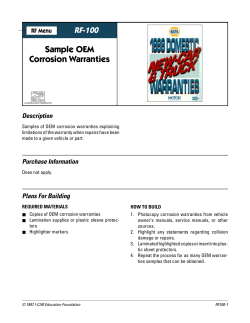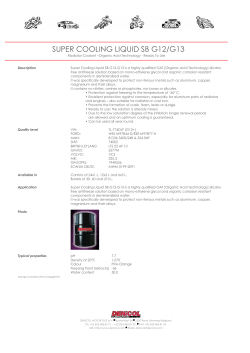
User Guide for Nautical Anchor Chains the new dimension of stainless
the new dimension of stainless User Guide for Nautical Anchor Chains October 2014 2 General Informations for your cromox, Anchor Chain Your cromox anchor chain offers a multitude of benefits. There are several considerations that need to be taken into account. The corrosionresistance protection of stainless steel is created by the combination of chrome and oxygen to form chromium oxide. The chromium oxide layer, often called the protection layer, is as a barrier against corrosion and protects the steel. There are many varieties of stainless steels with considerable differences in quality. For anchor chains, the material’s compatibility to be made into a chain and the corrosion-resistance of the material are of utmost importance. 1. Proper Care For long-use of your cromox chain, the following are strongly suggested: •Clean the chain with freshwater in the anchor chest before it is connected. •The chain should be regularly cleaned with fresh water after usage. •Avoid constant contact with saltwater-exposed cordage. •Strictly avoid any contact with rusted materials. Contact with rust particles or materials, which may rust, can become embedded on the surface of stainless steel chains. Rusty particles can infect the stainless steel and rusty spots may develop or the chain may develop a rusty-red surface color. •The chains’ smooth surface must be maintained. If the chain develops or shows one or more sharp burrs, they should be smoothed immediately as these spots will be more susceptible to corrosion. Last Reviced: October 2014 User Guide •Keep the chain free from organic materials. Anchoring in brackish water, the risk of corrosion will increase through sediments, microorganisms and the growth of biological layers or bio fouling. Microorganisms embedded on the chains’ surface and their growth can corrode stainless steel. 2. Mainte nance d The anchor chain should be regularly inspected. •Before the anchor chain is inspected, it must be thoroughly cleaned. Any type of non-corrosive cleaning method is permissible. High-heat, abrasive cleaning, and any method that could hide any damages must be strictly avoided. •Ensure sufficient lighting is used for the inspection and all parts of the chain thoroughly and carefully checked. The following are reasons to take the anchor chain out of service and conduct maintenance/repair: u Inability to extend or deform chain links. u The nominal thickness of the chain link is < 90 % (Fig. 1) because of wear and tear. d2 A d1 A A–A d + d2 1 2 = < 0,9 x dn (Abb. 1) u Damages (cuts, burrs, furrows, cracks, discoloration caused by heat, extensive corrosion, bent or curved chain links or other any defects) are observed or suspected. 4 3. Materials Ketten Wälder uses the following materials in cromox chain production: 1.4404, also named AISI 316L or S31603 •Compared to 1.4307, the corrosion resistance is significantly higher. •Excellent resistance against corrosion in natural environmental media (fresh water, rural and urban environments), as well as in industrial settings with moderate chlorine and salt concentrations, such as the food and beverage, pharmaceutical, and agricultural industries. •Due to the low carbon contents, this material is resistant against intercrystalline corrosion after welding. This material is not seawater-resistant. 1.4462, also named AISI 318LN or S31803 This steel belongs to the family of duplex steels (DSSs). This steel is valued for its higher-resistance against corrosion compared to austenitic steel 1.4404. •The austenitic-ferritic structure increases the resistance against stress - crack corrosion and pitting even in high chlorine concentration and low pH environments. •1.4462’s resistance in seawater generally is very good, but under harsh settings and improper maintenance, corrosion cannot be ruled out. Last Reviced: October 2014 User Guide 4. Chain Selection The selection of anchor chain materials is guided by the bodies of water and water temperature, where the vessel will be anchored. •Freshwater - 1.4404 In freshwater environments, corrosion is not of great concern. However, in and around swim ming pools and in air, which is heavily polluted through industry or agriculture, corrosion cannot be excluded. •Saltwater -1.4462 Salty coastal and sea air can lead to corrosion on the surface of low- corrosion resistant alloys such as 1.4307. Insufficient maintenance/hand ling of durable alloys like 1.4404 can also lead to corrosion. In water, the chloride concentration is the most crucial factor to corrosion susceptibility. Sample Chloride Concentrations Chloride Concentrations (appr.) Groundwater and clean 10 - 40 mg/l surface water Surface water polluted by raw sewage 40 - 250 mg/l Atlantic Ocean/North Sea 19.000 mg/l 8.900 mg/l Baltic Sea 15.000 mg/l Dead Sea Mediterranean Sea/ 21.000 mg/l Persian Gulf 6 Pitting-Resistance-Value/PRE The Pitting-Resistance or PRE - Value is used for a more accurate calculation of an anchor chain’s corrosion resistance in chlorine media. Stainless steels are generally regarded as seawater resistant with a PRE - Value of at least 33. PRE-Values: Material1.43071.4404 1.4462 PRE-Value 16,50 – 20,26 23,10 – 28,50 30,85 – 38,07 Ketten Wälder GmbH guarantees a PRE - value of at least 35 for chains made of 1.4462 steel. Critical Pitting Temperature-Value To calculate the variable water temperate on pitting corrosion, the CPC value is used. This value indicates the critical temperature at which pitting corrosion can develop for each respective material. Material1.43071.4404 1.4462 5. Types of Corrosion CPT-Value 10° C 24,0 – 27,5° C 27,5 – 34,5° C 50° F 75.2 – 81.5° F 81.5 – 94.1° F Surface corrosion Surface corrosion seldom occurs with anchor chains. The chain is considered resistant to surface corrosion if the loss of material is less than 0.1g/ m2 x h or less than 0.11 mm thickness/year. Last Reviced: October 2014 User Guide Intercrystalline Corrosion cromox chains are resistant against intercrystalline corrosion. Crevice Corrosion Crevice corrosion occurs when crevices develop between construction materials such as between screw heads and bolts or between bolts and holes. The risk of crevice corrosion is even greater at gaps between stainless steel and plastic parts. To avoid or reduce the risk of crevice corrosion, the cromox chain must be properly installed. Pinholing/Pitting Corrosion Pitting/pinholing is the most common type of corrosion on anchor chains. The protecting layer of the steel becomes damaged and these areas become more susceptible to corrosion. If the protection layer cannot repair itself in the damage causing water, then small holes will develop. The small holes will be rusty in color. A reliable indicator of pitting corrosion is the CPT - value. d Influencing Factors for Corrosion The corrosion of anchor chains is influenced by multiple factors. Deposits and sediments are most damaging to anchor chains. Microorganisms can initiate or even increase corrosion through their metabolism. 8 d Attention Service and repair are to be conducted only by the manufacturer. The experts at Ketten Wälder are happy to assist customers in their selection of the most suitable material for their anchor chain needs. Last Reviced: October 2014 User Guide 10 Protection Layer Certification Warranty Check Warranty Extended to: Date / Stamp/ Signature Warranty Extended to: Date / Stamp/ Signature Warranty Extended to: Date / Stamp/ Signature Warranty Extended to: Date / Stamp/ Signature Last Reviced: October 2014 Warranty User Guide Customer Information First name Last name Company Street Postal code/City Telephone Purchase Date Chain Customer No Code PRE-Value Dealer information Company Street Postal code/City Telephone A manufacturer’s warranty only applies when the required information is provided and an original sales receipt is presented. Please keep this record for safekeeping as Ketten Wälder cannot be held responsible for lost documentation. Warranty For anchor chains made of 1.4404/AISI 316L , there is no warranty against corrosion. For Anchor chains made of 1.4462/AISI 318LN , the following warranty conditions strictly apply: Ketten Wälder GmbH guarantees electropolished chains made of 1.4462 steel for a period of 3 years from date of purchase and tumbled polished chains out of 1.4462 for 2 years from date of purchase. The warranty can be extended by the manufacturer if the chain is returned to our service center in Bad Endorf, Germany for inspection by our technicians at the end of its regular warranty period. If our technicians find your chain to be in good condition without major damages, the warranty will be extended. Where repairs are advised, an estimate will be provided. We can also refresh the surface protection layer for a nominal service fee. By filing a claim under warranty, you will not be extending the warranty period. Warranty exception clause Excluded are any defects caused by improper usage, overloading, damage from irregular usage, contact with rocks, corals and similar elements, as well as rust and corrosion through contact with non-stainless steels. If the chain is used improperly, the warranty is immediately invalidated. Liability exception clause The manufacturer is not liable for any compensation for damages for loss, damage of any materials of any kind, bodily injuries and similar. Ketten Wälder GmbH Chain Technology Im Gewerbegebiet 5 83093 Bad Endorf, Germany Tel + 49 (0)80 53-20 29-10 Fax +49 (0)80 53-20 29-31 info@ketten-waelder.de www.cromox.eu
© Copyright 2025









